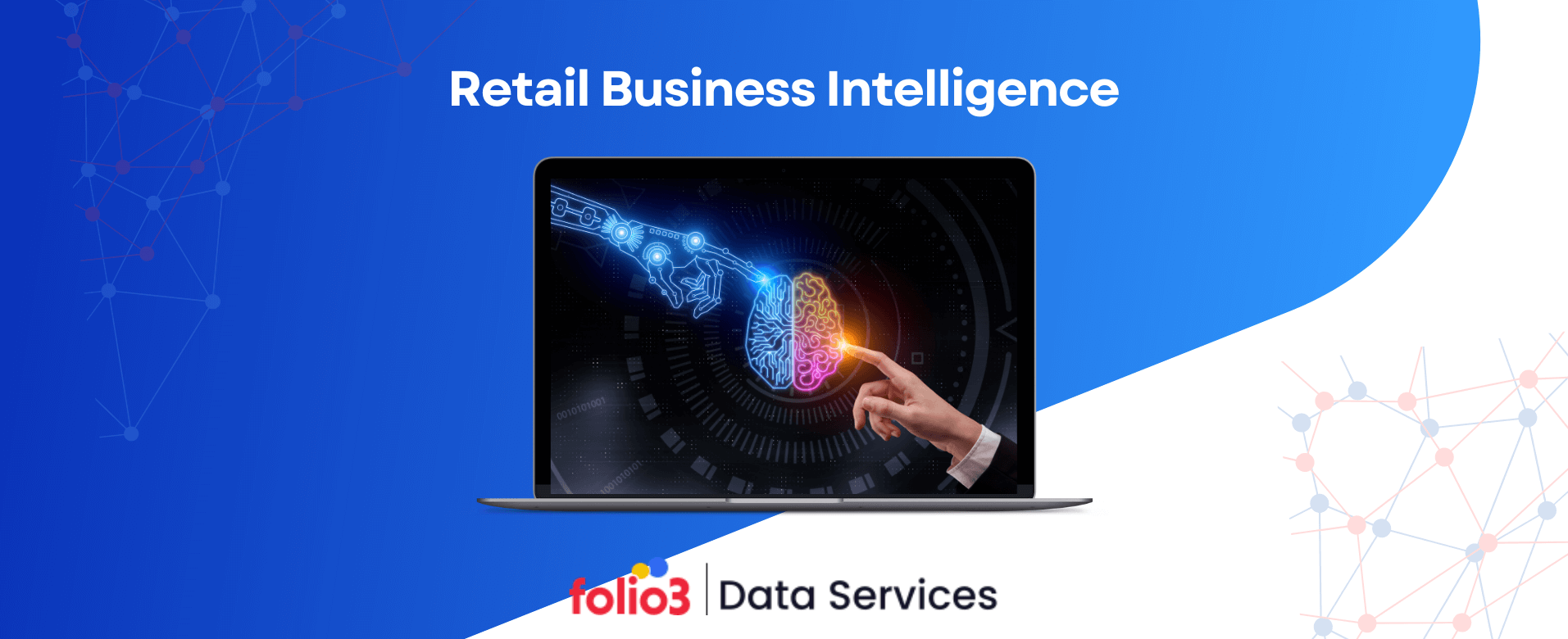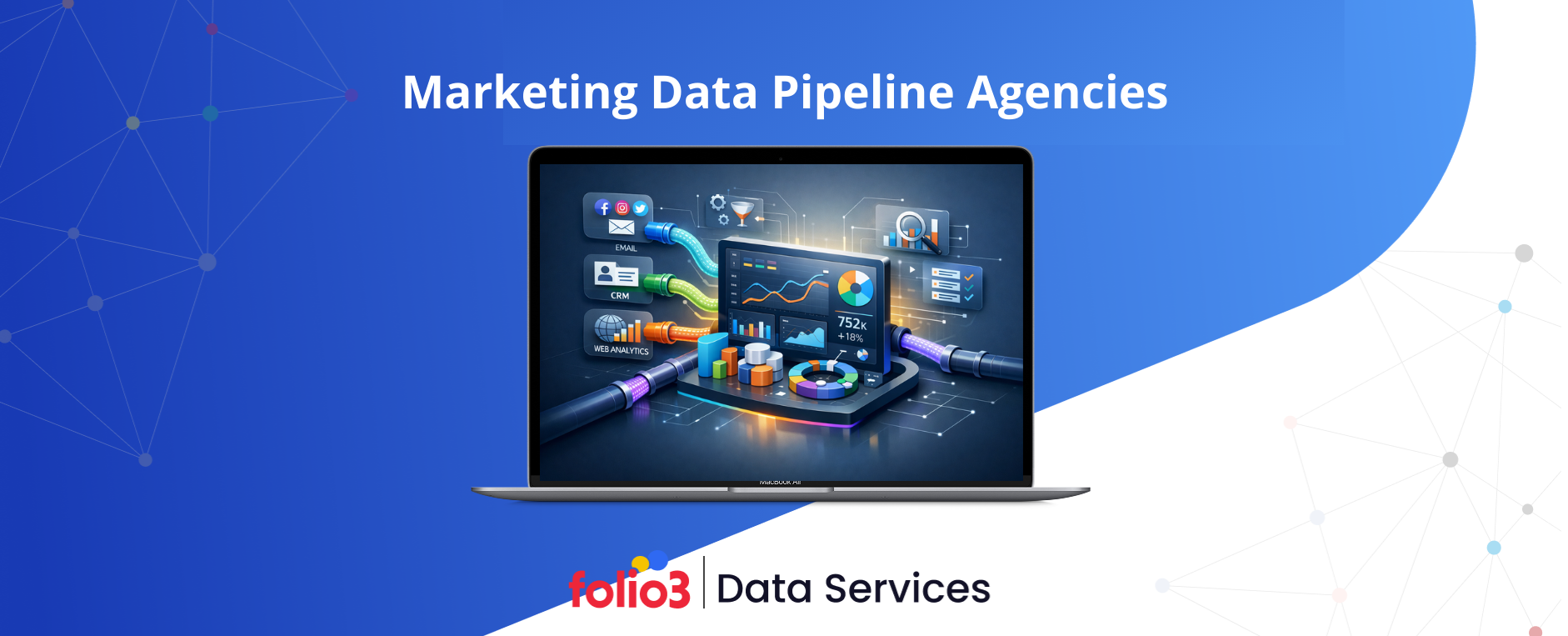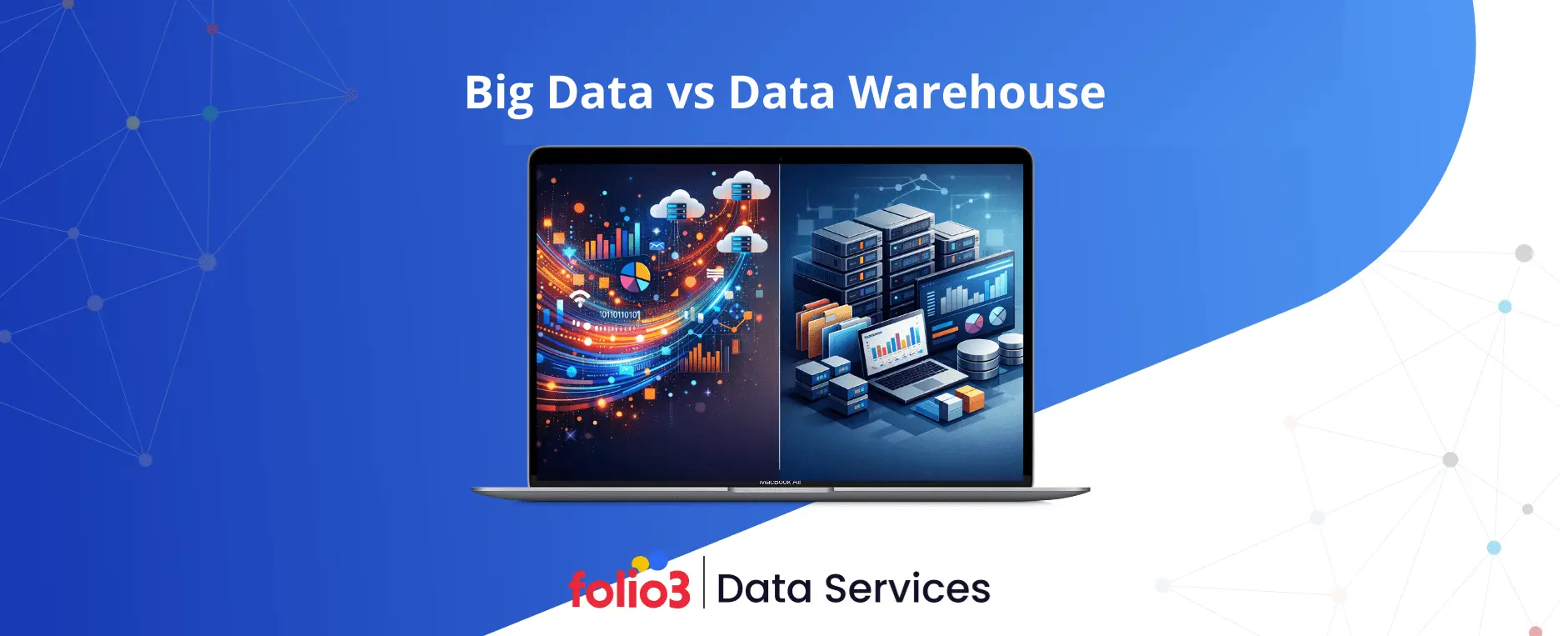Business intelligence (BI) has become a critical tool for success. Business intelligence (BI) involves using data to extract actionable insights that can drive better decision-making and streamline operations. This capability is more valuable than ever in the retail industry as retailers strive to enhance customer experiences, improve operational efficiency, and boost profitability.
Retail BI helps businesses use data from various sources, such as customer interactions, sales, and inventory, to view their performance comprehensively. With the help of retail business intelligence solutions, retailers can identify trends, predict future behaviors, and adapt to changing market conditions.
This blog explores retail business intelligence (BI), its key metrics, the benefits it offers, and how retailers can use it for better business outcomes.
What is Retail Business Intelligence?
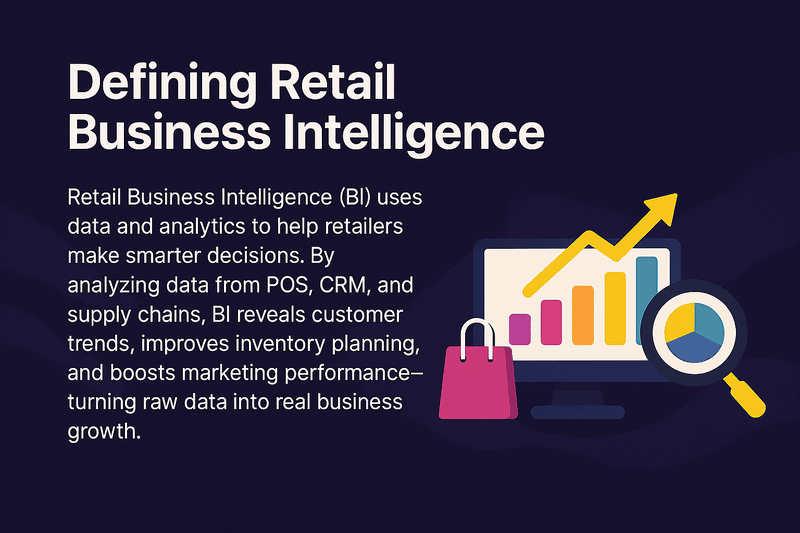
Retail business intelligence (BI) refers to using data analytics tools and techniques in the retail industry to collect, analyze, and interpret data to improve decision-making processes. It encompasses technologies and strategies that help retailers understand customer behavior, optimize inventory, and enhance marketing efforts.
Using BI, retail businesses can transform raw data into meaningful insights that directly impact sales, operations, and customer satisfaction. Retail BI solutions enable retail data monetization by aggregating data from various systems, including Point of Sale (POS), Customer Relationship Management (CRM), and supply chain management tools.
This allows retailers to visualize performance metrics, analyze consumer preferences, and identify growth opportunities.
Key Metrics in Retail Business Intelligence
Retail business intelligence (BI) provides a wealth of insights by tracking a variety of key performance indicators (KPIs). These metrics are essential for retailers to understand their business operations, optimize processes, and make informed decisions that enhance profitability. By tracking these KPIs, retailers succeed in turning data into actionable insights that support strategic growth and operational efficiency.
Here’s a detailed breakdown of the critical metrics that retail BI tracks:
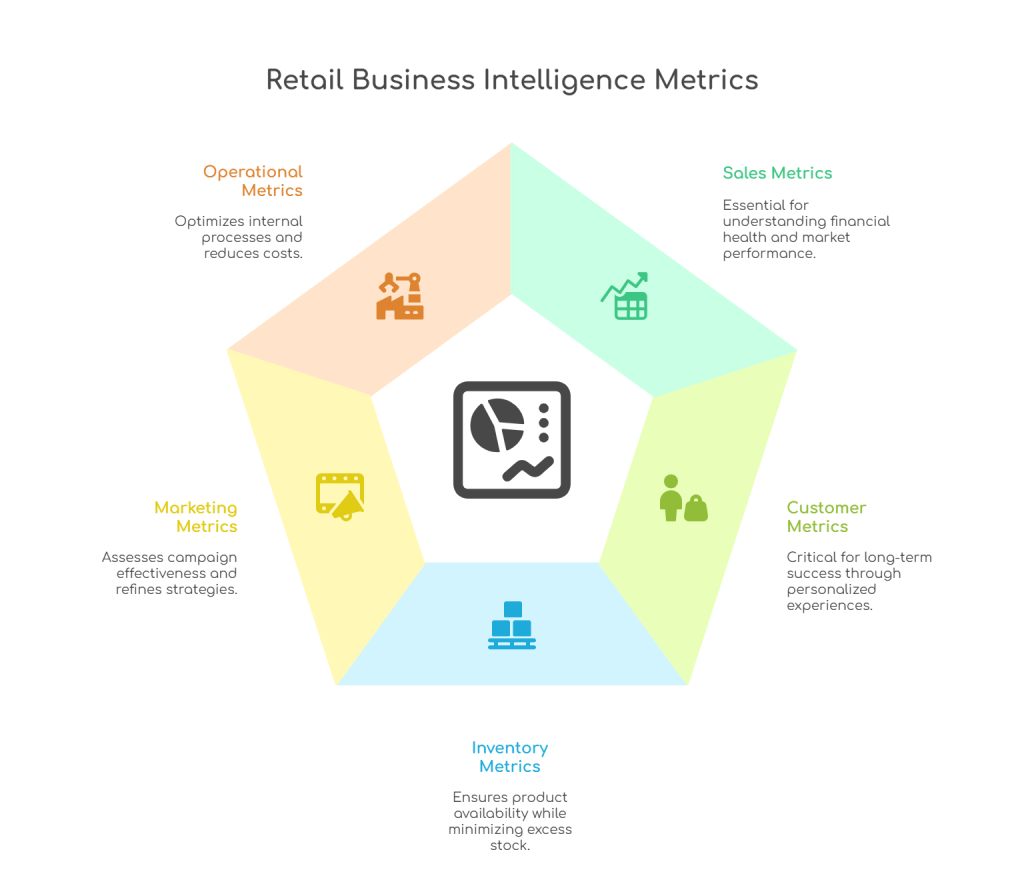
1. Sales Metrics
Sales metrics are essential for understanding a retailer’s financial health and overall market performance. Business intelligence in the retail industry enables retailers to track various KPIs, providing valuable insights into revenue generation and product performance. Many companies leverage professional business intelligence services to implement these solutions effectively and extract maximum value from their data. Key sales metrics include:
- Total Sales: This metric gives an overview of a retailer’s revenue over a specific period. Retail BI can break this down further by day, week, month, or year.
- Sales by Product Category: Tracking sales by product category helps retailers understand which categories are most profitable. This insight helps optimize product offerings and inventory.
- Sales by Store Location: Retailers with multiple locations can use BI to compare sales across different stores. This data helps identify high-performing stores and pinpoint areas where performance improvements are needed.
- Sales per Employee: Understanding sales per employee helps retailers evaluate staff productivity. This metric allows businesses to recognize top performers and address areas where additional training might be required.
- Profit Margins: Retail BI also tracks profit margins, providing insights into which products or services are the most lucrative. Retailers can adjust pricing strategies or promote high-margin items accordingly to maximize profitability.
2. Customer Metrics
Customer data is critical to long-term retail success. Retail business intelligence in the retail industry tracks customer behaviors and preferences, enabling retailers to offer personalized experiences. By working with a data strategy consultant, retailers can further refine their approach to data-driven customer engagement.
Customer metrics include:
- Customer Demographics: BI systems collect data on customer demographics such as age, gender, income, and location. Retailers can use this information to tailor their product offerings to match their customer base.
- Purchase History: Retail BI tools help retailers track what customers are buying, when, and how often. This insight allows for personalized recommendations and targeted promotions, increasing customer satisfaction and loyalty.
- Customer Lifetime Value (CLV): This metric represents the total revenue a retailer can expect from a customer over their relationship. Understanding CLV helps retailers focus on nurturing their most valuable customers and improving retention.
- Customer Engagement Levels: Retailers can track how often customers interact with their brand, whether through online platforms, in-store visits, or customer service channels. High engagement often correlates with loyalty, and low engagement can signal potential churn, prompting corrective action.
- Customer Segmentation: By analyzing customer metrics, BI tools enable retailers to segment their audience into distinct groups based on buying behavior, demographics, or preferences. This segmentation helps with personalized marketing and inventory planning, facilitated by customer analytics consulting.
3. Inventory Metrics
Effective inventory management is crucial to retail success, as it ensures products are available when customers want them while minimizing excess stock. Retail BI helps retailers optimize inventory control by tracking:
- Inventory Turnover: This metric shows how quickly products sell and are replenished. A high turnover indicates efficient inventory management, while low turnover might suggest overstocking or poor product selection.
- Stock Levels Across Locations: Retailers with multiple stores or warehouses benefit from tracking stock levels across locations. BI tools ensure that inventory is balanced, preventing stockouts at one location while another sits with excess stock.
- Reorder Points: Retail BI tools help retailers set automated reorder points for products. When stock dips below a certain level, the system triggers a reorder to ensure continuous availability, minimizing the risk of stockouts.
- Stockouts and Overstocks: Retail BI tracks how often stockouts (running out of an item) or overstocks (excess inventory) occur. By monitoring these situations, retailers can better balance supply and demand, reducing lost sales or storage costs.
- Days of Supply: This metric tells retailers how long their current inventory will last based on sales trends, helping them avoid both overstocking and stock shortages.
4. Marketing Metrics
Business intelligence in marketing provides essential insights into performance, helping retailers assess the effectiveness of their campaigns and refine strategies for better results. Important marketing metrics tracked by BI include:
- Customer Acquisition Costs (CAC): This metric calculates how much it costs to acquire a new customer through various marketing efforts. By analyzing this, retailers can ensure they are getting the best return on investment (ROI) from their marketing spend.
- Return on Investment (ROI): Retailers use BI to measure the ROI from individual marketing campaigns across different channels, such as digital advertising, email marketing, and in-store promotions. This enables retailers to allocate their marketing budgets effectively.
- Campaign Performance: BI tools allow retailers to monitor how different marketing campaigns perform in real-time. This includes tracking website traffic, email open rates, click-through rates, and conversion rates.
- Customer Retention Rates: BI systems track how well marketing efforts succeed in retaining customers, providing insights into the effectiveness of loyalty programs and customer retention strategies.
- Cross-Sell and Up-Sell Success: BI tools can help track the success of cross-selling and up-selling strategies, measuring how often customers purchase additional or upgraded products when presented with related offers.
5. Operational Metrics
Operational efficiency is a key driver of profitability in retail. A well-executed business intelligence strategy empowers retailers with visibility into internal processes, enabling them to optimize workflows and reduce costs. Some of the essential operational metrics include:
- Employee Performance: Retail BI tracks individual employee performance, measuring factors like sales per employee, hours worked, and customer service ratings. This data helps managers allocate resources efficiently and recognize top performers.
- Store Efficiency: For retailers with multiple locations, BI tools monitor operational efficiency at each store. This includes tracking metrics like sales per square foot, foot traffic, and staff-to-customer ratios, which helps in resource allocation and store management.
- Supply Chain Efficiency: BI tools track the performance of supply chain operations, including delivery times, supplier performance, and transportation costs. By identifying bottlenecks or inefficiencies, retailers can streamline supply chain operations and reduce costs.
- Customer Service Response Times: Retail BI tracks customer service performance, including response times to customer inquiries and complaint resolution rates. Fast, efficient service leads to higher customer satisfaction and improved brand loyalty.
- Labor Costs: BI systems monitor labor costs in relation to sales performance, ensuring that staffing levels are appropriate and aligned with demand, particularly during peak periods.
Benefits of Retail Business Intelligence
Adopting business intelligence in the retail industry offers a variety of benefits, from improved decision-making to enhanced customer satisfaction. Here are some of the key advantages:
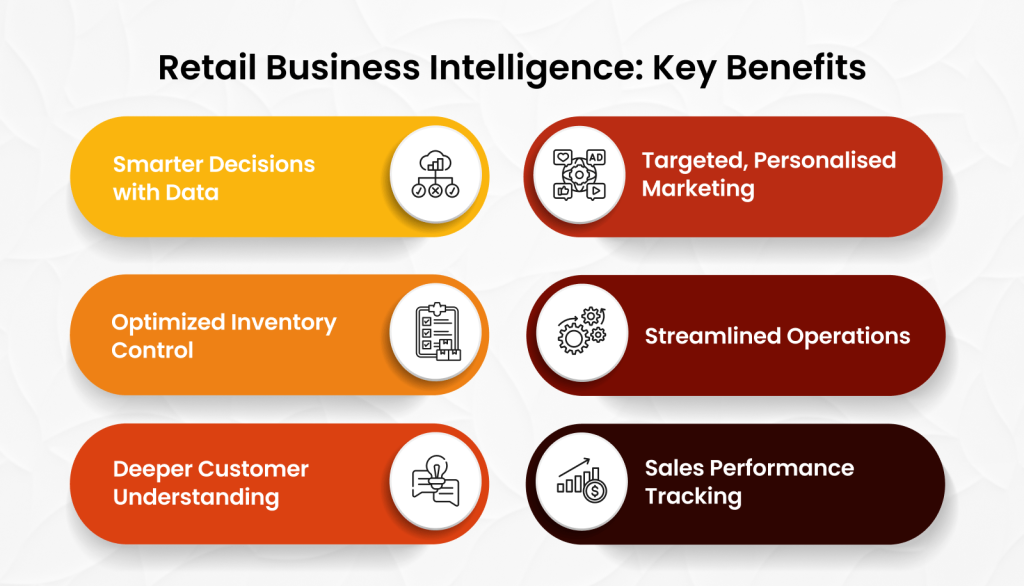
Data-Driven Decision Making
Retailers can make informed decisions by using benefits of real-time analytics to back up their strategies. BI enables businesses to identify patterns and trends, allowing them to adjust their operations based on data rather than intuition.
Improved Inventory Management
Retail BI provides real-time insights into inventory levels, helping retailers avoid stockouts and overstocking. This leads to optimized inventory levels and better supply chain management.
Enhanced Customer Insights
Retail BI tools help retailers understand customer preferences, purchasing behaviors, and feedback, leading to improved customer engagement and loyalty.
Personalized Marketing
With BI, retailers can segment their customers based on behavior and preferences, enabling personalized marketing campaigns. This leads to higher conversion rates and better customer satisfaction.
Operational Efficiency
BI tools provide visibility into the operational aspects of the business, helping retailers streamline processes, optimize labor usage, and reduce costs.
Sales Performance Tracking
Retail BI allows businesses to monitor sales performance at various levels—individual store, region, or entire chain—enabling retailers to identify high-performing stores and replicate their success elsewhere.
Key Functionality of Retail Business Intelligence
Retail business intelligence solutions come with a range of functionalities that enable retailers to use data effectively:
Data Aggregation
Retail BI solutions collect data from multiple sources (POS, CRM, ERP, e-commerce platforms) and consolidate it into a unified view, enabling retailers to analyze data holistically.
Data Visualization
BI tools allow users to visualize data through dashboards and reports. This simplifies the analysis process and helps stakeholders quickly understand trends and patterns.
Predictive Analytics
With predictive analytics, retailers can forecast future trends such as customer demand, inventory needs, and market shifts. This includes retail demand forecasting, which helps businesses plan more effectively, optimize inventory levels, and minimize risk.
Real-Time Monitoring
Retail BI tools provide real-time data updates, allowing retailers to monitor sales, inventory, and customer activity as they happen. This facilitates swift decision-making and immediate adjustments.
Customer Segmentation
Retailers can segment their customers based on purchase history, demographics, and behaviors, enabling targeted marketing and personalized service.
Supply Chain Management
BI tools help retailers track and optimize their supply chains, ensuring timely deliveries, minimizing transportation costs, and improving supplier relationships.
Sales Analysis and Reporting
Retail BI provides comprehensive sales analysis, enabling retailers to understand product performance, seasonal trends, and customer preferences. Through business intelligence reporting, detailed reports can be generated to help management track performance against goals and make data-driven decisions.
Integrations for Retail Business Intelligence Solutions
To maximize the effectiveness of retail BI, seamless integration with other business systems is essential. These integrations are often supported by robust data engineering solutions that ensure smooth data flow, transformation, and accessibility across platforms. Key integrations include:
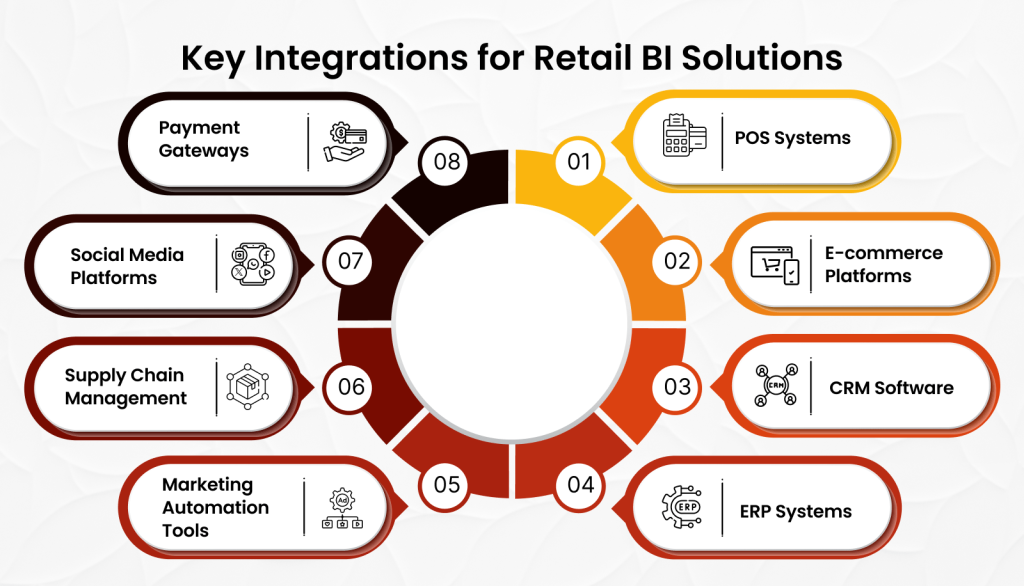
Point of Sale (POS) Systems
Retail BI solutions integrate with POS systems to track sales transactions, product performance, and customer purchase behavior in real time.
E-commerce Platforms
By integrating BI tools with e-commerce platforms, retailers can track online sales, customer preferences, and website traffic, helping them optimize the online shopping experience.
Customer Relationship Management (CRM) Software
Integration with CRM software helps retailers track customer interactions, preferences, and purchase history, allowing for more personalized marketing and customer service.
Enterprise Resource Planning (ERP) Systems
Retail BI integrates with ERP systems to provide insights into finance, operations, inventory, and supply chain management, ensuring smooth business operations.
Marketing Automation Tools
Integrating BI with marketing automation tools allows retailers to analyze the effectiveness of campaigns, track customer responses, and optimize future marketing efforts.
Supply Chain Management Systems
Retail BI tools help streamline supply chain operations by providing insights into supplier performance, delivery times, and inventory levels.
Social Media Platforms
BI tools can analyze data from social media channels, helping retailers track brand sentiment, engagement rates, and customer feedback.
Payment Gateways
Integrating BI with payment gateways provides insights into transaction data, allowing retailers to understand payment trends and customer preferences for payment methods.
Final Words
Retail business intelligence is a powerful tool that enables retailers to use data to drive strategic decisions, optimize operations, and enhance customer experiences. Partner with Folio3 Data Services for their BI solutions, so as a retailer you can unlock the full potential of their data, ensuring you can stay competitive in an ever-evolving market. As retail continues to embrace digital transformation, using business intelligence in the retail industry will be key to success.
